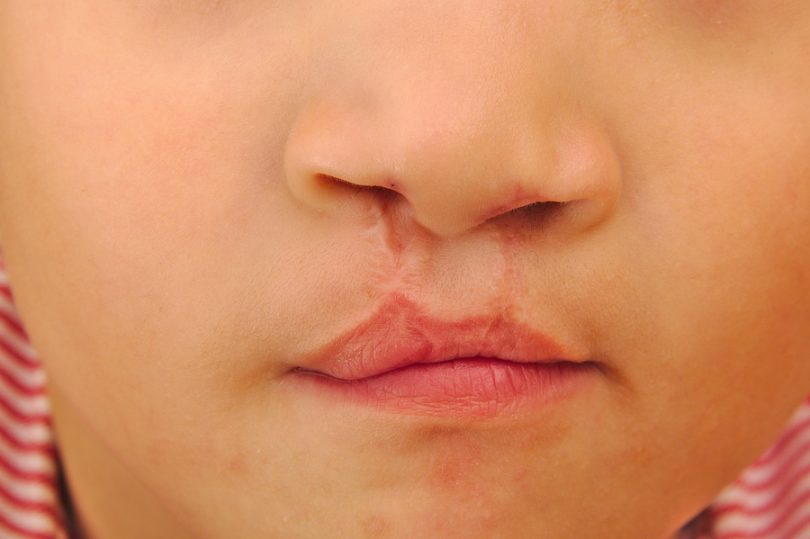In the film Wonder, based on the novel of the same name, August Pullman is a fifth-grader with facial differences who attends a mainstream elementary school for the first time.
It’s an incredibly inspiring—and accurate—depiction of what life, both good and bad, can be like for a child born with a birth defect.
In particular, for families with children born with a cleft lip and/or palate, the kind of life their child will have is also one of their primary questions—after, “Why did this happen to my baby?”
Cleft lip and/or palate, also known as an oral-facial cleft, is one of the most common congenital conditions, affecting one in every 700 births. While there may not necessarily be a good answer to the “why,” the good news is that with persistence, dedication and regular care, oral-facial clefts can be repaired successfully, said Dr. Jack Yu, a plastic surgeon at the Craniofacial Center at the Children’s Hospital of Georgia—which isn’t something that can be said for many congenital conditions.
The next 20 years
Babies with an oral-facial cleft are usually diagnosed during the second trimester ultrasound. Parents may be afraid, tearful and also depressed when they learn that the multistage repair process to correct an oral-facial cleft takes 20 years.
“It’s a complex multifactorial issue,” said Yu, whose craniofacial center is one of only two in Georgia that treat children born with an oral-facial cleft. “While the care involved can seem daunting, I always tell parents to take it stage by stage. The most important thing a parent can do to help their child achieve normal appearance, normal speech, normal hearing and a normal life after an oral-facial cleft is to work with their team of medical providers and complete every stage since each builds upon the previous.”
Stage by stage
Even before the baby is born, Yu advises parents to visit the American Cleft Palate-Craniofacial Association website (acpa-cpf.org) for helpful videos to teach them how to feed their newborn. “Failure to thrive”—when a newborn is unable to gain weight—is the major worry, well before any surgery.
“Babies with oral-facial cleft aren’t able to suck properly, so they cannot feed directly from the breast—although breast milk is still recommended. Instead, they must use a specially designed, squeezable bottle with a longer nipple and a larger aperture so it’s easier for the pumped breast milk to flow through,” explained Yu. “Parents also need to hold their baby in a more upright position.”
Yu compares it to trying to drink from a straw with a hole cut into the side. “That’s what it’s like for a baby with a cleft trying to drink,” he said. “But with a little practice, in 95 percent of cases, both mom and baby will learn.”
Care for a baby with cleft requires a team, which could include a pediatrician, neonatologist, speech therapist, orthodontist, pediatric surgeon, otolaryngologist, audiologist and psychologist. Most children with an oral-facial cleft go through the following stages:
Immediately after birth: Nasoalveolar molding
For children with a severe oral-facial cleft, the orthodontist will construct a specially molded “denture” that will provide a platform for the baby’s nose and mouth and help prepare the mouth for the first surgery.
It’s also important to note that the orthodontist will play a key role over the child’s next 20 years. Additional bracing and other treatments are a major part of care and help result in more successful surgeries.
At 6 months: Lip repair surgery
At the same time that a pediatric surgeon repairs the lip, an otolaryngologist will examine the baby’s ears and may put in tubes since children with cleft are at higher risk for ear infections, which if left untreated could damage the hearing.
At 1 year (and before 1.5 years): Palate repair surgery
Palate repair takes place before a child starts to talk to reduce any chance that a cleft will affect how the child learns to speak. After surgery, the team continues to monitor dental, speech and hearing. Some children may still have problems with liquid or food coming up the nose, which could be a structural issue that would need additional treatment. Or, a speech therapist might have to work with your child to help him or her relearn how to use the palate to control the movement of food and liquids.
At age 7 or 8 (just before adult eye teeth or canines arrive): Bone graft surgery
This surgery adds bone, taken from your child’s hip bone, to the gum ridge or front portion of the roof of the mouth. The bone graft helps fills in any cleft in the bone, which also allows adult teeth to come in properly.
Early teens: Patient support and counseling
This time can be tough for any child, but especially one with a cleft since their appearance is still being corrected. Help from a psychologist or other counselor can be beneficial, along with strong family support.
At age 16 for girls and age 18 for boys: Surgical correction of jaw position
Because there is less tissue in the upper jaw of children with cleft, as children grow, the lower jaw tends to jut forward. The appearance of the nose can also be affected. Physically, children may not be able to bite an apple or must eat pizza with a knife and fork. The surgery brings the upper jaw forward and essentially realigns the face.
At age 19: Nasal revision
The final surgery is to make any needed changes to the nose, since an oral-facial cleft can pull the nose to one side. This will also help improve the airway.
21 and counting
Yu has seen hundreds of children come through his center and go on to live successful lives.
His oldest patient was 65. He wasn’t able to receive surgery earlier because of financial issues and waited until Medicare was available.
Happily, that’s not the case with most, if not all, patients today. “But we continue to emphasize the importance of follow-through,” said Yu. “The commitment to a cleft repair is significant, but it also pays off significantly in a child’s well-being.”




